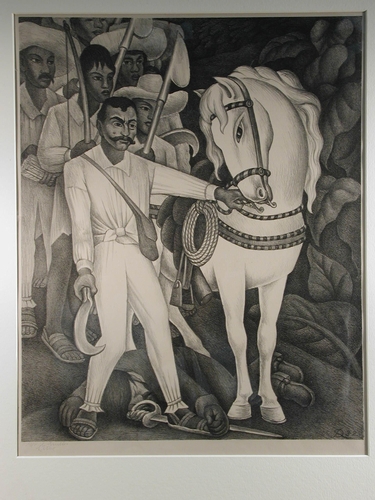
Diego Rivera-"Emiliano Zapata" 1932
Corrido del Plan de Ayala
Written by:Leonardo Kosta
Performed by: Tribu (Jesus Herrera,AlejandroMendez,and Agustin Pimentel)
1980

Diego Rivera-"Emiliano Zapata" 1932
|
|
En mil novecientos once
|
La Plan de Ayala:
Published on November 28, 1911 the Plan of Ayala has been termed, “Hallowed
as a sacred text in the Mexican people’s exodus from Porfirian bondage
into the promised land of Revolution” (Knight, 309). In publishing this
document, Zapata met with key supporters, such as local schoolmaster Otilio
Montaña in the hills near Villa de Ayala to discuss the turmoil of the
era. Through their deliberations a two-pronged attack was scripted: first, a
denunciation of Madero, and secondly, a call for agrarian reform (Knight, 309).
The authors of the Plan of Ayala first list the myriad of grievances against
Dictator Francisco Madero. They write, “It has been clear and patent that
he has outraged the sovereignty of the states, trampling on the laws without
any respect for lives or interest, as has happened in the State of Morelos,
and others, leading them to the most horrendous anarchy which contemporary history
registers” (Womack, 401-402). The text continues to berate Madero, characterizing
him as “Incapable of governing because he has no respect for the law and
justice of the pueblos and (is) a traitor to the fatherland” (Womack, 402).
Thus, the Zapatistas officially denounce the Madero regime, critical of his
unjust and unscrupulous style of leadership.
The Plan of Ayala also demanded agrarian reform. It is important to note at
this time that the plight of the Mexican agrarian farmer was in tremendous jeopardy
with modernization threatening to replace manual labor. “The balance between
land and work had been broken by the disproportionate growth of the modernized
hacienda and the peasant’s survival was severely compromised” (Warman,
93). “The mechanization of modern industries enabled them (large agrarian
enterprises) to increase production appreciably without increasing employment
and even, in some cases, reducing it” (Warman, 95). This threat of modernization,
coupled with the constant competition from foreign markets and ever-present
corrupt government officials who did little to ensure suitable working conditions
and rights for peasants, created a perilous environment for peasant farmers
and a paradox of progress. Always conscious of the common man’s struggles
Zapata used firm language to incite agrarian reform. Under the Plan of Ayala,
“Not only would the illegally usurped lands of the villages be restored,
as Madero had promised, in addition one-third of all rural ‘monopolies’
would be expropriated to provide land for the landless and any ‘landlords,
científicos or bosses who opposed the Plan would be liable for total
expropriation’” (Knight, 310).
Thus, the Plan of Ayala serves as a significant milestone in the discourse of
the Mexican Revolution and the life of Zapata. As Warman explains, “With
this program, notable for its consciousness, the Zapatistas ceased being local
rebels only to become revolutionaries seeking power with the aim of realizing
structural changes in the whole society” (Warman, 97).
To read the actual Plan of Ayala use these links:
* In English: http://historicaltextarchive.com/sections.php?op=viewarticle&artid=127
* In Spanish: http://www.patriagrande.net/mexico/emiliano.zapata/index.html